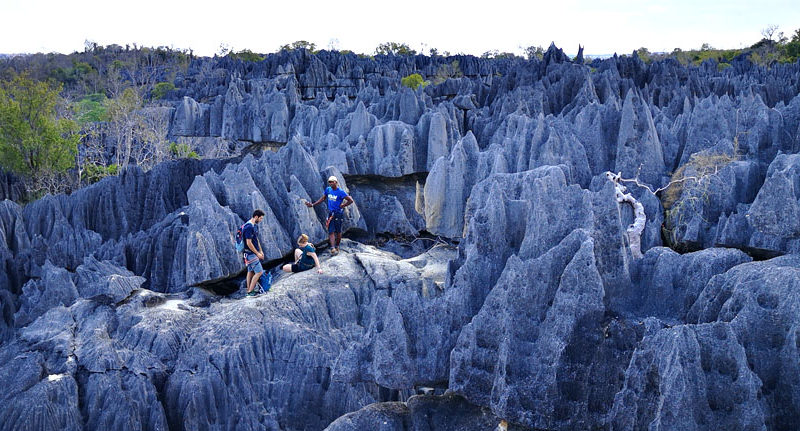East:
Predominant natural habitat is humid forest (‘rainforest’), Madagascar’s most species-rich habitat. Rainforests stay lush and green year-round. They are watered by moisture off the Indian Ocean that is precipitated by the eastern escarpment. Trees very tall in lowlands, but shorter in higher-elevation forest. Species distribution within eastern rainforest is complex. Many lemurs and frogs, and some reptiles, have small and localized distributions, often within specific elevations. Vast deforestation; much of eastern zone now covered in scrubby secondary forest and artificial savannah. Lower-elevation forests have been most drastically impacted. The highest mountains support open heath and grassland above treeline. These habitats are species-poor. Eastern marsh is one of Madagascar’s most special and most threatened habitats. It supports several endemic birds and many frogs.
West:
The western two thirds of Madagascar, comprising the central highlands and the western lowlands, are much drier than the east, lying in the rain shadow of the eastern mountains. Originally covered in dry deciduous forest, which has lower diversity than rainforest, but is still rich, with many endemics. Lemurs and reptiles are especially rich in the west, while frog diversity is low. Most of the west is now savannah in which mango and palms are prominent. Large areas have also been converted to rice cultivation. Most (although not all) of the trees in the western forest are deciduous: they lose their leaves during the dry season. The abundant leaf-litter and more open character of this habitat make it very different from eastern rainforest. The west holds extensive wetland habitat: marshes, lakes and wide rivers. Most have been degraded by humans.
North:
The north is essentially a mix of the eastern and western zones. Here the island tapers to a point, while general climatic trends are also disrupted by Tsaratanana, Madagascar’s highest mountain massif. The Sambirano region around Nosy Be is the only area on the west coast that sees almost as much rainfall as parts of the eastern zone. Some parts of the north, such as Amber Mountain and Lokobe National Parks (NPs), hold rainforest. This forest lacks the diversity of eastern rainforest, but does support many localized endemics. Much of the north, such as Ankarana NP, holds dry forest like that of the western zone. Large stretches are also covered in human-created savannah habitat.
Centre:
Mostly above 800 m (2,600’) elevation. Before humans arrived, Madagascar’s central highlands probably supported a mix of savannah and forest. But this is the part of Madagascar that has been most heavily impacted by human activity and is now dominated by arid grasslands and eroded gullies. Another feature of the centre is vast areas of rice cultivation. Rice paddies do support some birds and frogs. Forest persists in a few places, mainly in valleys where it is shielded from burning. Such forest resembles eastern rainforest, although it is drier and supports fewer species.
Southwest:
The southwest is the driest part of Madagascar. Its aridity has given rise to the island’s most distinctive habitat, the spiny forest. There is also some gallery forest and wetland. Least diverse of Madagascar’s zones, but supports many endemic species. The plants are fascinating, with most endemic not just to Madagascar, but to this zone.
Coast:
Madagascar’s 10,000 kilometres (6,200 miles) of coastline encompass mangroves (mainly in the west and north), mudflats, rocky and sandy beaches, and salt marshes. Supports many species of birds, along with sea turtles and marine mammals. Coral reefs are beyond the scope of this book, but Madagascar’s reefs are world-class.
HT AGENCY TOURS
Luxury Madagascar with the best luxury African safari tours packages. Discover your next perfect destination with HT Agency Tours

